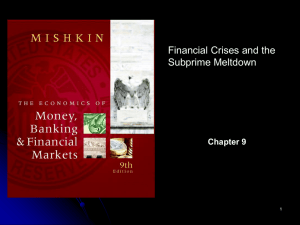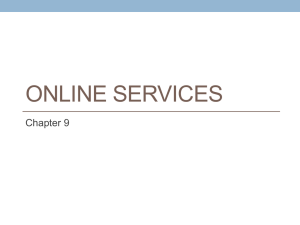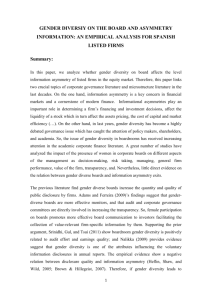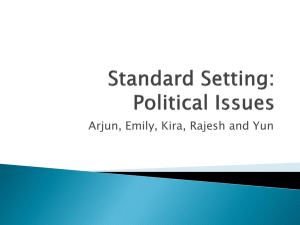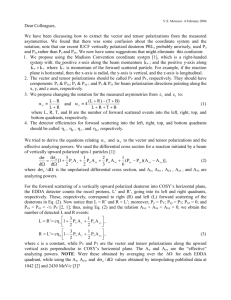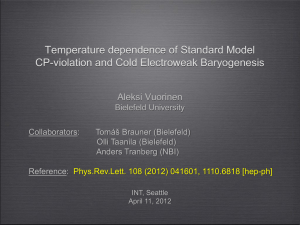Financial markets - Department of Development Studies
advertisement
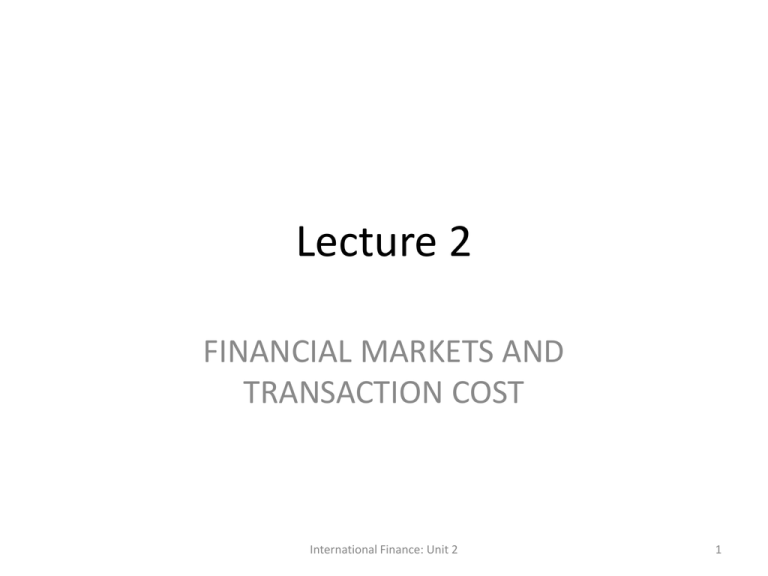
Lecture 2 FINANCIAL MARKETS AND TRANSACTION COST International Finance: Unit 2 1 Readers • Allen et al (2011), African financial systems: A review. Rev. of Dev’t Finance I:79-113. • Burton and Lombra (2006), The financial system and the economy: Principles of money and banking, 4ed. Thomson-South Western. International Finance: Unit 2 2 Learning objectives • After this unit of the module, you should know: – The various ways of classifying financial markets. – The nature of the African financial system. – Basic concepts underlying the operations of financial markets International Finance: Unit 2 3 Lecture Plan • Introduction • Financial Markets • Basic concepts underlying financial market operations • Conclusions International Finance: Unit 2 4 UNIT 2: FINANCIAL MARKETS AND TRANSACTION COSTS FINANCIAL MARKETS International Finance: Unit 2 5 Financial Market • Type of financial claim: – Equity Market – Money Market – Bond Market – Foreign Exchange Market • Length of term for which instrument is traded: – Money market – Capital market • Primary and secondary markets International Finance: Unit 2 6 1. Classification based on type of financial claim • Equity market – Market for the buying/selling of stocks/shares and derivatives eg. LSE,JSE, ZSE etc. • Bond market – Market for buying and selling bonds issued by governments-municipal and national governments, corporates etc. • Foreign exchange market – Buying and selling of foreign currencies and derivatives. • Money market – Buying and selling short term papers or instruments. International Finance: Unit 2 7 2. Length of term for which instrument is traded • Money market – Market for financial assets with original maturity of less than one year. – Eg. Treasury bills, commercial paper and NCDs • Capital market – Market for financial assets with an original maturity of more than one year. – Eg. Corporate bonds, stocks, mortgages and Government Treasury notes and bonds International Finance: Unit 2 8 3. Primary and Secondary Market • Primary market – The market in which a security is sold for the first time. [Security, financial instrument or claim may be used interchangeably]. – New issues such as IPOs are sold in the primary market. • Secondary market – The market in which previously issued securities are sold. • The difference between the two markets are only conceptual ..eg of car dealerships, pre-owned and new cars are sold on different lots on the same premises. • While the secondary market do not generate new funds for issuers that raised capital on the primary market, the mere existence to the secondary market improves the market for new issues. International Finance: Unit 2 9 4. Whether arranged transactions occur instantaneously or in the future • Spot market – A market in which the trading of financial securities take place instantaneously. • Financial futures market – Organised markets that trade financial futures agreements. – Securities are standardized in terms of quantities and delivery dates. – Eg. There are four contracts in a year. March, June, Sept. and December. • Financial forward markets – Markets that trade financial forward agreements usually arranged by banks, brokers or other dealers. International Finance: Unit 2 10 • Derivative market – Financial futures market where the value of the financial instrument( the futures and forward agreements) “derive” their values from the underlying instruments such as gov’t bonds, shares of equity, commodities, etc that are traded on a future date. – Financial forward and futures markets are examples of derivative markets. International Finance: Unit 2 11 Unit 2: Financial Markets INTERNATIONAL FINANCIAL ARCHITECTURE International Finance: Unit 2 12 International Financial Architecture • • • • • • Bilateral donors Private/commercial sector/banks etc Multilateral donors Global funds NGOs Private philanthropy International Finance: Unit 2 13 International Finance System Bilateral Donors DAC Donors: eg. EU Bilateral Development Banks & Agencies Other OECD Donors (non-DAC) Emerging Donors (eg. China* India,Brazil, South Korea etc) Private Commercial Sector Firms (e.g. FDI, corporate social responsibility) Multilateral Donors The World Bank Global Funds NGOs Global Environment Facility International NGOs (CARE Int., PLAN Int., Oxfam etc) The Global Fund, GAVI National NGOs in Donor Countries IMF Commercial Banks (eg. loans, export credit, export guarantees) Private Investors (e.g. portfolio and equity investments) UNDP Regional Development Banks, eg, ADB Other banks, Islamic Dev. Bank etc UN special agencies International Finance: Unit 2 National NGOs in Developing Countries Private Philantropy Bill and Melinda Gates Foundation;Ford Foundation; Wellcome Trust, etc Householdsremittances and other private transfers 14 AFRICAN FINANCIAL SYSTEMS International Finance: Unit 2 15 Introduction • Continent of 53 countries • Economically and cultural diverse • Varying financial systems at different levels of development • Reviews is done regionally: – North Africa – West Africa – East Africa – South Africa International Finance: Unit 2 16 Themes covered • • • • Banks Non-bank institutions Money and capital market Microfinance institutions International Finance: Unit 2 17 Foreign banks as a percentage of total banks by region Region 2000 2006 Eastern Africa 44 56 Northern Africa 29 37 Southern Africa 51 56 Western Africa 51 54 Source: Allen et al (2011) as quoted from Stijn et al, 2008 International Finance: Unit 2 18 Market capitalisation, listings and liquidity of the main stock exchanges 2009 Region Country East Africa Kenya Northern Africa Southern Africa capitalization Listings Turnover Trade/Cap. 39 55 4.59 1.65 Tanzania - - Uganda - - Egypt 48 305 60.07 28.04 Morocco 69 78 45.73 32.38 Tunisia 23 49 16.23 3.18 Botswana 34 20 2.74 0.89 - - Malawi Mauritius 55 88 8.06 3.38 Namibia 9 7 2.84 0.24 246 363 57.27 119.76 5 - - - - South Africa Swaziland Zambia West Africa Cote d’Ivoire 20 38 2.01 0.58 Ghana 16 35 1.96 0.37 11.01 2.71 Nigeria 20 Finance: Unit 2142 International 19 Structure of financial markets presentation • • • • Introduction Financial Markets International financial architecture African financial system International Finance: Unit 2 20 UNIT 2: FINANCIAL MARKETS AND TRANSACTION COSTS CONCEPTS UNDERLYING THE OPERATIONS OF FINANCIAL MARKETS International Finance: Unit 2 21 Concepts • • • • • • • Transaction cost Economics of transactions The principal-agent problem Asymmetric information Adverse selection Moral hazard Conclusion International Finance: Unit 2 22 Introduction • Financial markets operate within an institutional framework or system. • The aim here is to get the system to function in an optimal manner. • Challenges in most developing countries hamper development of the financial markets and that affects economic growth negatively. • Challenges often arise from the high transaction cost. International Finance: Unit 2 23 Transaction cost • This is the cost incurred in undertaking an economic or financial transaction. • Financial intermediation is a critical factor in the determination of transaction cost. • Financial intermediation plays four roles: – Provision of adequate liquidity risk sharing – Reduction of inefficiencies arising from information asymmetry – Alignment of incentives to reduce moral hazard and adverse selection – Facilitation of scale economies International Finance: Unit 2 24 Liquidity risk sharing “risk to a bank’s earnings and capital arising from its inability to timely meet obligations when they come due without incurring unacceptable losses.”* Source: Office of the US Comptroller, 2000 International Finance: Unit 2 25 Transaction cost cont’d • Good intermediation contributes to the reduction of financial costs. • Government has a role in the provision of an enabling environment that reduces transaction cost: – Provision of sound regulatory environment – Enforcement of property rights • Components of transaction cost: – Search cost – Enforcement – Measurement etc International Finance: Unit 2 26 Economics of contract • The relationships in the financial market is governed by a number of contracts. • Market participants and the markets themselves are regulated by contracts. • Contracts are often not perfect but efforts can be made to produce efficient and workable contracts. • Complete contracts addresses every foreseeable contingency. But they don’t exist. • Legally incomplete contracts are contracts based on available information and sometimes unverifiable information. International Finance: Unit 2 27 Economics of contracts cont’d • The cost of the design and enforcement of contracts may be reduced with good legal and institutional infrastructure. • Incomplete contracts have a negative impact on transaction costs. • The differentiation of formal economies from informal ones is largely dependent on whether the design and enforcement of contract is achieved in a formal way or in an informal way. • The principal-agent phenomenon is another factor that has an impact on transaction cost International Finance: Unit 2 28 The Principal-agent Problem • Also referred to as the agency dilemma based on the work of Ross (1973) and Jensen and Meckling (1976). • The theory describes the challenges from conditions of asymmetry of information when a principal hires an agent. • The principal and agent usually don’t have the same set of motivations. • But the agent is supposed to pursue the interest of the principal. • Mechanisms are adopted to ensure the alignment of the motivations of the two parties. International Finance: Unit 2 29 Principal-agent theory, cont’d. • Tools to ensure that the agent pursues the interest of the principal include: – – – – Commissions Profit sharing Performance contracts Share options (sometimes taken to absurd levels) • “fat cat” pay. On top of salaries executives usually receive share options. The right to acquire shares in the company at some point in the future at concessionary rates if certain targets are met. – Threats of dismissal International Finance: Unit 2 30 Principal-agent problem cont’d • Separation of corporate ownership and control comes with agency costs. • The principal-agent problem is largely due to information asymmetry between the agent and the principal. International Finance: Unit 2 31 Asymmetric Information • This is related to decision making in transactions when one party has more or better information than the other. • Akerlof (1970) forms the basis of the theory regarding asymmetric information. – “The market for lemons: qualitative uncertainty and the market mechanism”. • Asymmetric information explains to a large extent the inefficiencies in the financial markets in which DFIs operate. • Akerlof argues that asymmetric information explains the existence of the adverse selection problem. International Finance: Unit 2 32 Information asymmetric cont’d • The absence of equal access to information by the two parties involved in a transaction also constitute information asymmetry. • There may also be unequal capacities to process available information. • Information asymmetry is very important issue for an efficient credit market. • Absence of effective credit markets do not promote entrepreneurship. • The availability of credit promotes economic growth (Levine et al, 2000). International Finance: Unit 2 33 Information asymmetry – cont’d. • One of the key financial market where information asymmetry is important is the credit market. • Developing country markets faces higher information asymmetry and that is reflected in the size of the credit markets. • Domestic credit to the private sector in most developed countries is over 100% of GDP. • The figure is around 20% for most countries in Africa. • Tanzania, 16%; Senegal, 24% and Zambia, 15%. • Mauritius , 88%; SA, 145%. • US, 190%; UK, 210% International Finance: Unit 2 34 Information asymmetry cont’d • Low credit levels is not entirely due to resource availability in the banking sector, its also because a small proportion of the total deposit mobilised is lent out. • The existence of high degree of information asymmetry means prospective lenders are unable to figure which borrowers are credit worthy. • Information asymmetry partly accounts for market imperfections or inefficiencies that characterise financial markets in developing countries. International Finance: Unit 2 35 Adverse selection • It arises from information asymmetry in a financial market, such as the credit market. • It is the challenge that confronts a lender in distinguishing between good-risk and bad-risk investments, because the borrower has information that the lender does not. • Also refers to a market process in which bad results occur due to information asymmetries between buyers and sellers. • The "bad" products or customers are more likely to be selected. Hence the term “adverse selection” International Finance: Unit 2 36 Adverse selection problem: Example 1 • If consumers are unable to determine the quality of a product because they lack full information, they pay an average price. • Because of the average price offered prospective sellers of quality products lack the incentive to offer their products for sale. • Sellers of bad products, “lemons”, sell their bad products at the price offered by consumers, hence, the term adverse selection. • Bad products are offered because the sellers don’t have much to loose. International Finance: Unit 2 37 Adverse selection: Example 2 • If investors can’t figure out the correct value of firms they offer to pay an average price for equity in those firms. • Good firms will not offer to sell equity because they expect higher than average valuations. • Bad firms rather offer equity for sale International Finance: Unit 2 38 Moral hazard • Moral hazard ensues when a party insulated from risk has the incentive to behave differently than it would behave if it were fully exposed to the risk. • It may also be seen as an example of information asymmetry where a contract or relationship places incentives upon one party to take (or not take) unobservable steps which are prejudicial to another party. International Finance: Unit 2 39 Example of moral hazard problem • Securitisation of sub-prime mortgages. – Securitisation is the process by which a company packages or bundles its illiquid assets into a security. • An example of risk transfer that has serious moral hazard implications. • When banks traditionally underwrite mortgages they bear the full risk of default, if the mortgages are bundled and sold the risk of default is transferred. International Finance: Unit 2 40 A view on subprime mortgages • “even the doziest mortgage broker can originate subprime mortgages for even the least creditworthy borrowers. The fact that the borrowers are incapable of making payments on the mortgage will magically be priced into the mortgage by the securitization process, which will bundle the mortgage with other mortgages originated by a similarly lax process and sell the lot to an unsuspecting German Landesbank attracted by the high initial yield. Everyone will make fees on the deal, everyone will be happy” [Hutchinson 2008]. International Finance: Unit 2 41 Moral hazard problem of too big to fail Source: The Economist. International Finance: Unit 2 42 Concluding Remarks • Financial development in most of Sub Saharan is not well developed, the markets are also fragmented. • Low level of economic development in Africa may be in part due to the poor state of the financial system. • Transaction cost and information asymmetry are some of the leading factors that account for the low level of financial intermediation. • The phenomena are responsible to a large extent the credit market imperfection associated with developing countries. • Policy measures that seek to foster efficiency in the financial market will have to include measures aimed at: – Enhancing transparency in the operations of financial institutions – Reduction of transaction cost from the perspective of both sides of the market. International Finance: Unit 2 43



